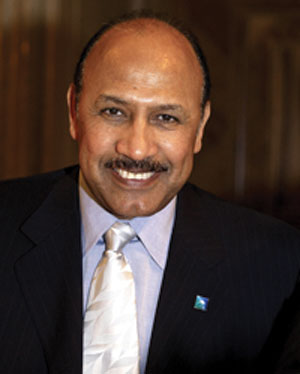 The World’s Energy Future
The World’s Energy Future
Saudi Aramco President and CEO Abdullah S. Jum’ah keynoted at the 20th World Energy Congress in Rome. World-Generation was credentialed.
By Dick Flanagan, Publisher
Saudi Aramco President and CEO Abdullah S. Jum’ah addressed the 20th World Energy Congress and asserted that there are enough conventional and non-conventional liquid energy resources available for petroleum to be a significant part of global energy for decades. He offered a statistical basis for his argument that forecasts the ultimate recovery of conventional oil resources have actually increased over time.
“In general, we have grossly underestimated mankind’s ability to find new reserves of petroleum,” Jum’ah asserts, “as well as our capacity to raise recovery rates and tap fields once thought inaccessible or impossible to produce. On balance, I am confident that this growth trend can continue. But confidence is no excuse for complacency, and I also believe we must take a hard look at the Earth’s total endowment of liquid fuels, and realistically assess our ability to meet future demand for energy.”
In addition to conventional oil, Jum’ah believes that non-conventional resources of liquid energy such as condensates, natural gas liquids, tar sands, bitumen, extra heavy oil, oil shales, gas-to-liquids, coal-to-liquids, and biofuels will ultimately contribute to the global supplies of petroleum that are currently meeting consumers’ needs. “The amount of conventional oil in place is somewhere between six and eight trillion barrels, depending on whether you go with the conservative or target scenario,” he said. “The volume of non-conventional oil in place is rather murkier, with a conservative figure of seven trillion barrels and a target scenario number of roughly eight trillion barrels or higher.”
“Let us remember that we basically know where these non-conventional liquids are located,” he continued, “and that there is little or no exploration work to be done when it comes to these resources”. Jum’ah went on to explain that most of the non-conventional resources are located in the Western Hemisphere which will play a greater role in the future of petroleum.”
Jum’ah noted that there are between 13 trillion barrels and 16 trillion barrels of total in-place liquids available worldwide if both conventional and non-conventional resources are considered. To put these figures in perspective, we have consumed only 1.1 trillion barrels of oil, or seven to nine percent of resources in place, nearly all of that was conventional oil.
Jum’ah emphasized that recovery of liquid energy resources, particularly non-conventional resources, will be impacted by a complex interaction of factors including advances in technology, recovery efficiency, demand and its growth, levels of financial investment, economics, policies pursued by both consuming and producing governments, and environmental considerations. He said that the world average recovery rate of conventional oil fields remains at 35 percent, “under the target scenario, the world as a whole could add up to a trillion barrels of additional reserves from known fields. Even under much more conservative assumptions made by some analysts in the conservative scenario, there will be another 200 billion barrels of conventional recoverable oil resources to be tapped from already discovered fields.”
Jum’ah stated that maintenance of the world’s conventional oil reserves is equally split between NOC’s and IOC’s. Access to practically all non-conventional reserves, however, falls to the IOCs. He also said that it is largely the IOC’s that are pursuing niche opportunities like ultra-deep water and Arctic plays. “The development of conventional and non-conventional liquid fuel resources will take place over many decades,” Jum’ah said, “and I will exercise caution in trying to stake out exact timetables. However, I believe there will be a predictable sequence to this development, as dictated by both technology and economics.”
Regarding bio fuels, Jum’ah noted that their growth will be the result of government policies and initiatives rather than market fundamentals. He spoke of the pressure that bio fuels exert on both arable land and on food supplies needed to feed a growing global population. He also addressed the resulting increase in the use of pesticides and fertilizers used in the production of bio fuels that is expected to have its own environmental implications. “Frankly, there are huge uncertainties associated with biofuels, and I think it is therefore difficult to predict with any degree of certainty their ultimate contribution to the global energy mix,” he said.
Tackling environmental issues associated with the energy industry was another major theme Jum’ah discussed. He feels the two most pragmatic and least disruptive methods of lightening the environmental impact of energy use and consumption are improved efficiency and R&D efforts. He also says that alternative energy sources such as nuclear, renewables, or even coal, though not applicable to the transportation industry, are needed and welcome.
“Eventually these fuel sources will become a more important component of global energy supplies,” he said, “but we must be realistic about the pace of their future development, and understand that for the foreseeable future, their significance in the energy supply mix will continue to be limited.” Jum’ah said not to worry about “peak oil” scenarios, but to worry about ignoring liquid fuels in our energy policies and investment decisions and discouraging its development and growth.
